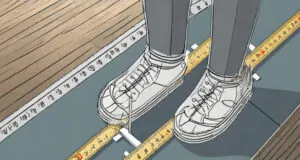Shoe sizes are typically labeled with a combination of letters and numbers to indicate different size variations. The letters “D” and “EE” are often used to denote the width of the shoe. Here’s what they generally mean:
D: Regular or Medium Width
The letter “D” stands for a regular or medium width. This is considered the standard width for most shoes. If you see a shoe size followed by the letter “D,” it means the shoe is designed for individuals with a standard or average foot width.
EE: Wide Width
The letters “EE” represent a wide width. If you see a shoe size followed by “EE,” it means the shoe is wider than the standard or medium width. This is suitable for individuals with wider feet who need extra space in the shoe.
So, when looking at shoe sizes, you may see something like “10D” or “10EE.” The number before the letter represents the length or size of the shoe, and the letter indicates the width. Keep in mind that shoe sizing systems may vary slightly between different brands and countries, so it’s always a good idea to check the specific sizing information provided by the manufacturer.
Introduction
Have you ever wondered what those mysterious ‘D’ and ‘EE’ letters mean next to your shoe size? Well, you’re not alone! In this blog post, we’ll unravel the mystery behind these letters, helping you understand the world of shoe sizes in simple and easy terms.
Shoes play a crucial role in our daily lives, providing comfort and support as we navigate the world. Understanding shoe sizes is essential for a pleasant walking experience.
What Does “D” Mean in Shoe Size?
‘D’ in shoe size is the standard or medium width for most shoes. This designation indicates that the shoes are designed to fit the average foot width. It’s often referred to as the “medium” or “standard” width, and as you mentioned, think of it as the Goldilocks zone – not too narrow, not too wide, but just right for a significant portion of the population.
When you see ‘D’ next to your shoe size, it means that the shoe is manufactured to accommodate the average width of feet. However, it’s important to keep in mind that individual foot shapes can vary, and some people may find that they need a narrower or wider width for optimal comfort.
For those who have wider feet, ‘W’ or ‘E’ widths are available, while those with narrower feet may opt for ‘N’ or ‘A’ widths. Finding the right width is crucial for ensuring proper support, preventing discomfort, and promoting overall foot health. It’s always a good idea to try on shoes or consult sizing charts and customer reviews to determine the best fit for your specific foot shape and width.
What Does “EE” Mean in Shoe Size?
‘EE’ width in shoe sizes is designated for wide-width shoes, providing extra space for individuals with wider feet. If you find that standard-width shoes are too constricting or uncomfortable, ‘EE’ width can be the solution. This width designation signifies that the shoe is crafted with additional width in the ball and instep areas, offering a more spacious fit.
Using the analogy of upgrading from a regular seat to an extra-wide one is a great way to understand the purpose of ‘EE’ width. It’s all about providing the necessary room for a more comfortable and accommodating fit, ensuring that the shoes don’t squeeze or pinch the feet.
When shopping for shoes, especially online, checking for width options like ‘EE’ can make a significant difference in finding the right pair for your feet. It’s important to prioritize comfort and support, and having the correct width is a crucial factor in achieving that. As always, trying on shoes, consulting size charts, and reading reviews can help ensure that you choose the right width for your individual foot shape and preferences.
Understanding Shoe Width

Shoe width is a crucial factor when it comes to finding the perfect fit. It’s not just about the length; it’s also about how snugly or roomy your shoes feel. Width is denoted by letters such as ‘D’ and ‘EE,’ indicating different widths for different feet.
Here’s a breakdown of common width designations:
Narrow Width:
-
- Letter designation: N or A
- Description: Narrow-width shoes are designed for individuals with narrower feet. They provide a snug fit to prevent the foot from sliding around inside the shoe.
Standard or Medium Width:
-
- Letter designation: M or D
- Description: Medium-width shoes are considered the standard or regular width. They are designed to fit most feet comfortably.
Wide Width:
-
- Letter designation: W or E
- Description: Wide-width shoes are designed for individuals with wider feet. They offer more space across the foot’s ball and instep to accommodate a broader foot shape.
Extra Wide Width:
-
- Letter designation: XW, EW, or EE
- Description: Extra wide-width shoes provide even more room than wide-width shoes. They are suitable for individuals with significantly wider feet.
How to Measure Your Foot Width:

Determining your shoe width is indeed important for finding comfortable and well-fitting shoes. Here are steps you can take to determine your shoe width:
1. Visit a Shoe Store:
- Many shoe stores have experienced staff and tools to measure both the length and width of your feet. They may use a Brannock Device, a common tool for foot measurement, to assess your foot size accurately.
2. Ask for a Foot Measurement:
- Approach a store associate and ask for a foot measurement. They will guide you through the processand provide you with your accurate shoe size, including both length and width.
3. Use a Ruler at Home:
- If you prefer to measure your feet at home, you can use a ruler. Here’s a simple guide:
- Stand on a piece of paper with your heel against a wall.
- Make a mark at the tip of your longest toe and at the back of your heel.
- Measure the distance between the two marks.
4. Consult a Width Chart:
- Many shoe brands provide width charts that correlate foot measurements to specific width sizes. Use the width chart to determine if you have narrow (N), standard (M or D), wide (W or E), or extra wide (XW or EE) feet.
5. Consider Your Comfort:
- Take into account your comfort preferences. If you’ve experienced discomfort with shoes being too narrow or too wide in the past, this can guide you in choosing the right width.
6. Read Reviews:
- Check customer reviews for specific shoe models and brands. Often, reviewers will mention how true to size the shoes are, including information about width.
7. Try Before You Buy:
- If possible, try on shoes before purchasing, or choose retailers with generous return policies. This allows you to assess the fit and comfort firsthand.
Your shoe size and width can change over time, so it’s a good idea to measure your feet periodically, especially if you haven’t done so in a while. Finding the right width is crucial for overall foot health and comfort.
Our Top Recommendation: What Does TD, GS, and PS Mean In Shoes
Why Does Width Matter?

Width matters because wearing shoes that are too narrow or too wide can lead to discomfort, pain, and even long-term foot issues. A shoe that fits just right, in terms of both length and width, provides the support your feet need and ensures a comfortable walking or running experience.
Imagine trying to squeeze into a pair of skinny jeans that are two sizes too small – uncomfortable, right? The same goes for shoes. Finding the right width ensures your feet have the breathing room they need without feeling cramped or swimming in excess space.
Common Foot Width Issues
A. Narrow Feet Challenges:
- Narrow feet can pose challenges in finding the right fit. Individuals with narrow feet may experience issues such as:
- Slipping Inside Shoes: Shoes designed for standard width may allow too much movement for narrow feet.
- Pressure Points: Narrow shoes can cause pressure points and discomfort.
- Limited Options: Some styles may not be available in narrow widths.
Overcoming Challenges:
- Look for shoes specifically labeled as narrow (N) or with an ‘A’ width designation.
- Consider adjustable features like buckles or straps to customize the fit.
- Choose brands known for catering to narrow-width feet.
B. Wide Feet Importance of “EE” Width:
- Individuals with wide feet face challenges that can be alleviated by choosing the right width:
- Pinching and Discomfort: Standard-width shoes can pinch and cause discomfort.
- Bunions and Corns: Tight shoes may contribute to the development of bunions or corns.
- Limited Toe Space: Standard-width shoes may not provide enough room for toes.
Enhanced Comfort with EE Width:
- Opt for shoes labeled with ‘W,’ ‘E,’ or ‘EE’ to ensure a wide fit.
- Check for styles that offer ample toe box space.
- Look for features like stretchable materials for added comfort.
C. Foot Width Variations and Overall Comfort:
- Foot width can vary, even within the same individual’s pair of feet. Understanding these variations is crucial for overall comfort:
- Asymmetry: One foot may be wider or narrower than the other.
- Arch Differences: Individuals with wide feet may also have high arches or vice versa.
- Impact on Balance: Improper width can affect balance and stability.
Addressing Variations for Comfort:
- Measure both feet and choose shoes based on the larger foot’s width.
- Consider orthotic insoles for additional support and customization.
- Choose footwear styles that accommodate variations in width and arch height.
Conclusion
In order to know the proper comfort of your footwear, understanding width is as important as knowing your shoe size. The ‘D’ and ‘EE’ widths cater to different foot types, ensuring everyone can find their perfect fit. So, the next time you’re shopping for shoes, pay attention to those little letters – they hold the key to comfort and happy feet!
If you find yourself spending long hours on your feet, I highly recommend checking out my previous blog post on the best shoes for clinical rotations. Discovering the right footwear can make a significant difference in comfort and support during those extended periods on duty. Your feet will thank you!
Frequently Asked Questions
How do I know if I need a “D” or “EE” width in shoes?
To determine the width you need, consider the natural shape and width of your feet. If your feet feel snug or cramped in standard-width shoes, you might benefit from a wider “EE” width. It’s crucial to prioritize comfort – if your toes feel squeezed or the sides of your feet feel pressured, opting for a wider width could be the solution.
Are “D” and “EE” the only width options available for shoes?
No, they are not the only options. The width of shoes is represented on a spectrum, ranging from narrow (typically labeled with letters like “A” or “B”) to wide (represented by letters like “D” for regular and “EE” for wider). Some brands may use different letters to denote widths, so it’s essential to check the specific sizing chart provided by the shoe manufacturer.
Can I wear a different width than what I measure for my shoe size?
It’s generally recommended to stick to your measured width for optimal comfort. Wearing a width that is too narrow or too wide can lead to discomfort, blisters, and other foot issues. If you find that your measured width doesn’t feel quite right, it’s a good idea to try on different sizes and widths to find the best fit for your feet.
Where can I find information about the width options for a specific shoe?
Most shoe brands provide detailed sizing charts on their websites or in-store. These charts typically include information about the available widths for each size. Additionally, customer reviews and feedback can offer valuable insights into how a particular shoe fits in terms of width.
Is there a significant difference between “D” and “EE” widths in shoes?
Yes, there is a noticeable difference. “D” is considered the standard or regular width, while “EE” is wider to accommodate a broader foot. The difference is usually around 1/8th of an inch per size increase. Choosing the correct width is essential for comfort and preventing foot-related issues, so it’s worth paying attention to the width options available.





